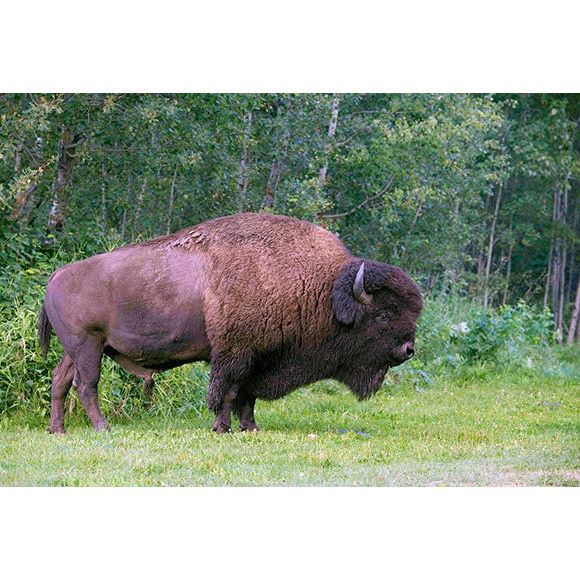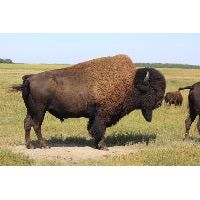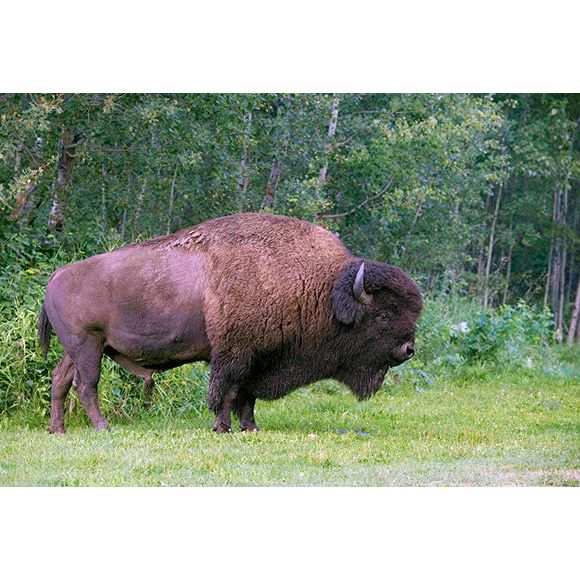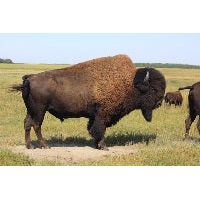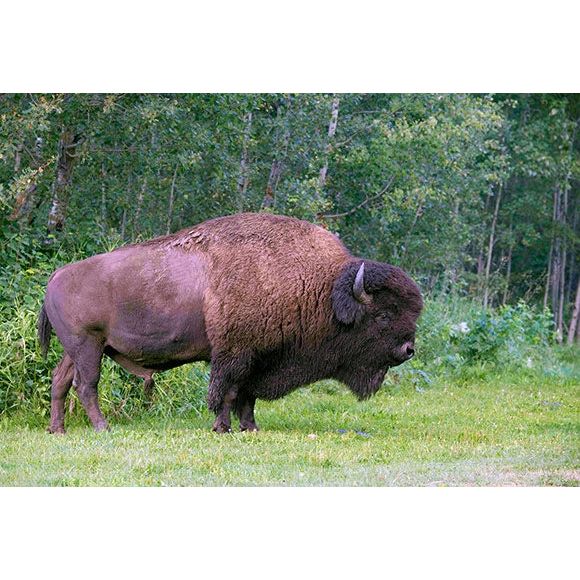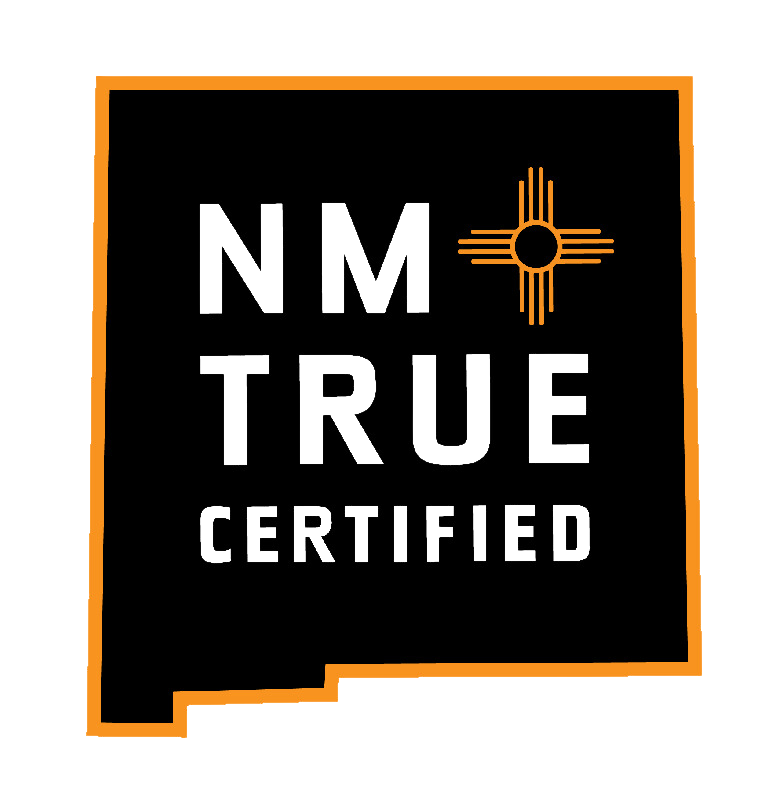Wood bison are the larger of the two subspecies of modern American bison. Adult males are approximately 6 feet tall at the shoulder, 10 feet long, and weigh more than 2,000 pounds. The females are smaller, generally weighing around 1,200 pounds.
The American bison occurs in two subspecies in North America, the plains bison (Bison bison bison) and the wood bison (Bison bison athabascae). Plains bison are somewhat smaller than wood bison. A bison’s head and forequarters are massive and seem out of proportion to the smaller hindquarters. A bison’s backbone begins to rise just ahead of the hips and reaches its maximum height about or behind the front shoulder. From above the shoulder, the hump drops almost straight down to the neck. In wood bison, the hump is taller and the highest point of the hump is further forward than in plains bison.
Bison have horns that curve upward. The horns of a bull are larger and heavier than the horns of a cow. In late fall, a bison’s coat is a rich, dark brown. As winter progresses, the coat changes color and is lighter colored by spring. When the weather warms, the hair loosens and hangs in patches until it is completely shed and replaced with new hair in the late spring. The hair on the chin resembles a goatee and is more pointed in wood bison. Older animals tend to have more hair on their heads.
Please Note: High volume and corporate orders may be subject to shipping charges, please reach out at 575-758-7709 for more information.
General Shipping Information
Our shipping rates are fixed relative to the amount spent, generally, and are listed below. They are some exceptions as the boxes get bigger or heavier. All the carriers charge more for bigger & heavier boxes. We are shipping with USPS Priority and UPS Ground. UPS is about 4 to 5 days, and USPS is 3- 5 days. We use Fed Ex for overnight shipping.
If one carrier is better for you to receive your order, please let us know.
Contact us at service@madeinnewmexico.com or at 505-469-2193.
- Standard Ground Shipping $0.00–$50.00 $9.50 USD
- Standard Ground Shipping $50.01–$100.00 $9.75 USD
- Standard Ground Shipping $100.01–$150.00 $11.25 USD
- Standard Ground Shipping $150.01–$199.99 $15.00 USD
- Standard Ground Shipping $200.00–$249.99 $15.00 USD
- Standard Ground Shipping $250.00 and up $25.00 USD
- USPS Priority Shipping (3-5 Days) $0.00–$200.00 $23.50 USD
*Note that some items, such as ristras, furniture, and heavy liquids are subject to weight-based shipping rates differing from the above and the rate will vary depending on the products' weights in your cart.
FedEx Next Day Shipping
-
Whether you are shipping to a customer or to family, near or far, there are times when it just needs to be there overnight. Choose next-business-day delivery. Take advantage of a variety of options with FedEx Priority Overnight and FedEx Standard Overnight. The order has to be into us before 10 am to be delivered the next day. Anything after that will not be delivered for 2 days. Ordering at 10 pm at night the order will not get there the next day & we will not refund the shipping. Overnight orders received after 10 am on a Friday will not go out until Monday.
- Delivery by 2:30 p.m. the next business day to most areas; by noon, 4:30 p.m. or 5 p.m. to remote areas. Available throughout all 50 states. Saturday pickup and delivery available in many areas for an additional charge.
Shipping to Military Addresses
- We ship to Military APO (Army Post Office) and FPO (Naval Fleet Post Office) addresses. All APO/FPO packages will be shipped by USPS Priority Mail. When shipping to APO/FPO addresses: USA is the country; the recipient's unit number is the address; APO or FPO is the city; AA, AP or AE is the state; and the zip code is entered just like a standard domestic zip code. Please test the address on the National Address Server and use all 9 digits of the zip code, if given. If you need more information on how to ship to APOs/FPOs, please visit this Post Office Page The Military Post Office System has a hotline for questions about shipping to APOs/FPOs: 1-800-810-6098.
Shipping to Canada
-
Please note: We do ship to Canada, but there may be additional taxes/duties charged that the recipient will be responsible for paying. This may also include delayed delivery and require that the recipient retrieve the item from a customs office.
How do I contact you?
Most questions can be answered simply by reviewing the information in our FAQ details. However, if you don't find the answer to your question there, visit this page: Contact Us. Nobody responds faster!
Can I Get a Catalog in the Mail?
Sorry, but we're too small to be able to publish a mail order catalog, and we are adding new Local New Mexico products all the time. If we did send out a catalog it would be out of date in a few weeks. We do offer an email newsletter that will tell you about our latest specials and new products.
I'm Nervous About Ordering Online. Can I Order by Phone?
Sure you can call us!! Contact Us here.
There Is A Product I Want, But I Don't See It Online. How Can I Get It?
Most everything we sell is listed right here on our website. If you don't see it, give us a call and we will do our best to find it for you, or you may have seen it at our Taos Store location, visit this page: Contact Us. Nobody responds faster!
I Just Checked My Online Banking Account, And It Appears You've Charged My Credit Card Twice!
Mistakes happen, but we will do our best to get this fixed as soon as possible. Please visit this page: Contact Us. Nobody responds faster!
What Payment Methods Do You Accept?
We accept VISA, Mastercard, American Express, Discover.
I Have A Coupon. How Do I Redeem It?
There is a box on the Shopping Cart Page a little down and to the left on that page that says "Coupon Code". Enter your code in that box and then press the "apply" button and the discount will be applied to your order.
Do You Offer Gift Wrapping?
Yes! Please see our gift-wrapping page for details.
What Is Your Return Policy?
We accept returns for pretty much any reason at any time, but we only accept those returns we have been notified to expect. See our return policy page for details or submit a return request by logging into your account.
What Shipping Methods Do You Offer?
We ship by UPS, and the United States Postal Service. Please see our shipping terms page for all the details.
When Will My Order Ship?
99% of orders ship within one business day: Order by 11am Mountain time and it will ship the same day!
Do You Ship Overseas?
No, we currently only ship within the US, US Territories, APO addresses and Canada
How Do I Track My Order?
When your order ships you will receive a confirmation email which contains your tracking number and a link to either Fed Ex or USPS.
Where Is Your Store Located?
We're a REAL retail store, not just a "virtual" one. Our Made in New Mexico store is located on the west side of the famous Taos Plaza. The address is 127 N. Plaza, Taos, NM 87571.
Do You Sell Wholesale?
No, we're a retail store and website.
How Do I Contact The Manufacturer Of A Product I Saw On Your Site?
We do not give out this information but will be happy to contact them on your behalf.
What Is Your Privacy Policy?
You can read it on our privacy page
Officially Certified
NEW MEXICO TRUE
Made in New Mexico® products epitomize authenticity, capturing the essence and rich cultural heritage of the region. When you shop at the official Made in New Mexico® store, you are guaranteed to receive products that are 100% authentic and crafted with the highest standards of quality. Whether you're shopping online or placing your order by phone, the store offers a seamless experience with fast shipping from New Mexico to Taos, ensuring that your orders arrive promptly. The Made in New Mexico® store is not just about fast and free shipping; it's about bringing a taste of New Mexico into your home. With a wide array of products including sauces and salsas, each item is a testament to the unique flavors and traditions of New Mexico. Plus, with special promotions like taking 10% off with a code, shopping for authentic New Mexican products has never been more appealing.




